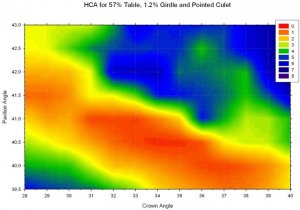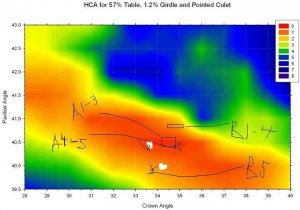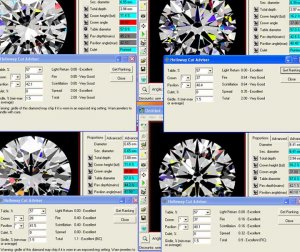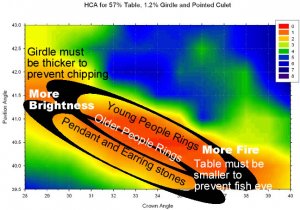Regular Guy
Ideal_Rock
- Joined
- Jul 6, 2004
- Messages
- 5,963
Garry,
Hoping you can help me here...
Though I know, rock paper scissors, idealscope may have your favor over this utility....HCA remains a convenient starting place in the search process for a diamond...witness the successful development of the search by cut utility here.
Also, from the point of view of "rubber meeting the road," and the way diamond shopping is frequently actually done with Pricescope being used as a resource...a shopper will start, and most frequently end their shopping process with the selection of diamond #1 that they say they want to see. Of course, your helpful admonition that it be used to reject bad performers, and narrow the process...is a good thing to understand, and qualify the HCA's use. Still, the practical matters of how it is used in actual practice for ultimate selection is something I am very mindful of.
Specifically, wanting to avoid providing poor direction concerning recommendations to any readers here on Pricescope motivates this thread. Wanting a little better understanding of how the HCA can be most helpfully applied and understood is the main intention here.
I've had reference to three ways to consider the application of the HCA.
1) For Regular Guys, the admonition...keep it between 0 - 2, and use this simple strategy to guide your initial selection. No complaints, and the simplicity of the idea stands up against the relatively similar simplicity of concepts relating to: color, clarity, i.e. G is better than I is better than K. VS2 is better than SI2 is better than I anything. Likewise, 0 - 2 is better than 2 - 4, etc. Likewise, the utility of the HCA allows for the implementation of a database like the search by cut utility here, as well.
2) But, at your other site dedicated to the development of HCA...the punchline I thought I understood as just a bit more involved...that the 0 - 2 score represents a composite of 4 elements, really: brilliance, fire, scintillation, and spread... and so...although the composite nature of the scores also includes the communication about a weighting of the relationship of these 4...still...more or less....when comparing two diamonds where brilliance (double weighting) are both excellent...then...you can actually compare two diamonds on the basis of the evaluation of their elements. In other words, although per (1): 0 - 2 is the target, per (2) regardless of the numbers between 0 - 2, more excellents trumps more very goods.
3) If my understanding of (2) is correct, I don't understand the concept behind your post quality only."
It seems to me that scores of lower than 1 only increase the chance of getting more excellents. Also, when the suggestion was made in recent post, Aljdewey commented on the 0 - 1 score, suggesting it may imply less contrast than would otherwise be the case. This may be true; is it? And if so, how does that work, exactly. Is there a basis in this idea, from the foundation of how a diamond gets this score?
Seeing the display of diamonds under the "search by cut" database and how they fall out, I wonder if the main point is simply that -- given 100 diamonds that appear there -- the majority will be 1 - 2. Perhaps it is then only a comment on their normal distribution, rather than a comment on the nature of those diamonds that happen to fall between 0 - 1.
Since my thinking in (2) is sort of different than what's been suggested in (3), since under the scenario of 0 - 1, there's simply a greater likelihood of having more, rather than less excellents...any advice on how to understand the basis for (3) is greatly appreciated.
Thanks in advance!
Hoping you can help me here...
Though I know, rock paper scissors, idealscope may have your favor over this utility....HCA remains a convenient starting place in the search process for a diamond...witness the successful development of the search by cut utility here.
Also, from the point of view of "rubber meeting the road," and the way diamond shopping is frequently actually done with Pricescope being used as a resource...a shopper will start, and most frequently end their shopping process with the selection of diamond #1 that they say they want to see. Of course, your helpful admonition that it be used to reject bad performers, and narrow the process...is a good thing to understand, and qualify the HCA's use. Still, the practical matters of how it is used in actual practice for ultimate selection is something I am very mindful of.
Specifically, wanting to avoid providing poor direction concerning recommendations to any readers here on Pricescope motivates this thread. Wanting a little better understanding of how the HCA can be most helpfully applied and understood is the main intention here.
I've had reference to three ways to consider the application of the HCA.
1) For Regular Guys, the admonition...keep it between 0 - 2, and use this simple strategy to guide your initial selection. No complaints, and the simplicity of the idea stands up against the relatively similar simplicity of concepts relating to: color, clarity, i.e. G is better than I is better than K. VS2 is better than SI2 is better than I anything. Likewise, 0 - 2 is better than 2 - 4, etc. Likewise, the utility of the HCA allows for the implementation of a database like the search by cut utility here, as well.
2) But, at your other site dedicated to the development of HCA...the punchline I thought I understood as just a bit more involved...that the 0 - 2 score represents a composite of 4 elements, really: brilliance, fire, scintillation, and spread... and so...although the composite nature of the scores also includes the communication about a weighting of the relationship of these 4...still...more or less....when comparing two diamonds where brilliance (double weighting) are both excellent...then...you can actually compare two diamonds on the basis of the evaluation of their elements. In other words, although per (1): 0 - 2 is the target, per (2) regardless of the numbers between 0 - 2, more excellents trumps more very goods.
3) If my understanding of (2) is correct, I don't understand the concept behind your post quality only."
It seems to me that scores of lower than 1 only increase the chance of getting more excellents. Also, when the suggestion was made in recent post, Aljdewey commented on the 0 - 1 score, suggesting it may imply less contrast than would otherwise be the case. This may be true; is it? And if so, how does that work, exactly. Is there a basis in this idea, from the foundation of how a diamond gets this score?
Seeing the display of diamonds under the "search by cut" database and how they fall out, I wonder if the main point is simply that -- given 100 diamonds that appear there -- the majority will be 1 - 2. Perhaps it is then only a comment on their normal distribution, rather than a comment on the nature of those diamonds that happen to fall between 0 - 1.
Since my thinking in (2) is sort of different than what's been suggested in (3), since under the scenario of 0 - 1, there's simply a greater likelihood of having more, rather than less excellents...any advice on how to understand the basis for (3) is greatly appreciated.
Thanks in advance!















300x240.png)